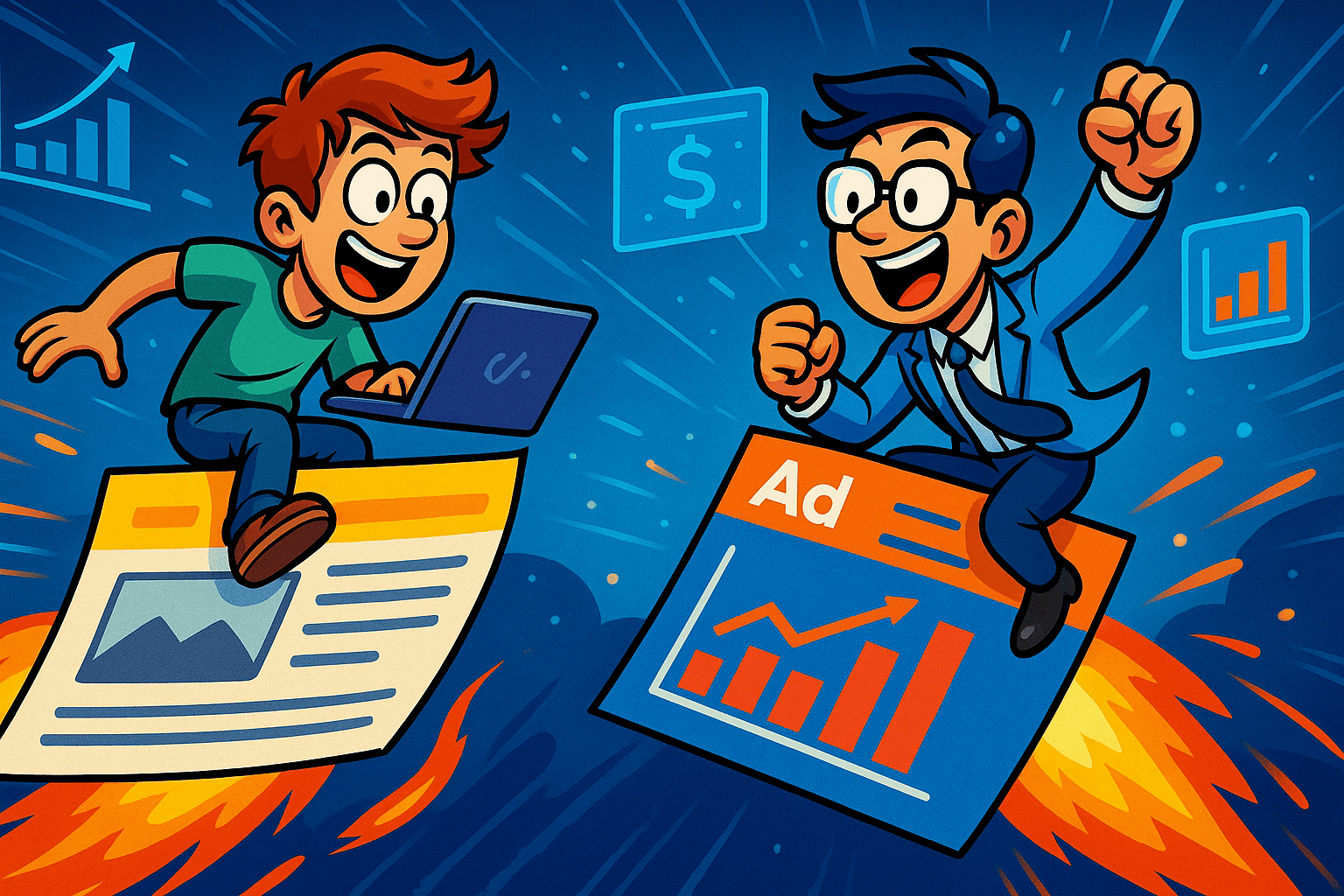For early-stage B2B SaaS founders, the go-to-market choice often feels like a fork in the road where they build authority and compound traffic with content, or buy speed and visibility with paid ads. Both can work “just on very different timelines, cost structures, and scale curves”.
Why this matters in Seed → Series A: In a world where every dollar counts and CAC production can decide your next funding milestone, choosing wrong burns the runway fast. We’ve worked with 40+ SaaS startups across fintech, HR tech, and cybersecurity (see About The Rank Masters) and watched how the “channel choice” moment shapes growth trajectories for years.
Here is the reality check:
▶️ Neither channel is “better” in all cases. Organic content builds a defensible moat but takes 6–12 months to mature.
▶️ Paid ads can deliver qualified leads in days, but without precise targeting, resonant creative, and solid conversion funnels (backed by CRO for product-led content), CAC spirals.
We’ve audited campaigns with $50k+ wasted on the wrong ICP and blogs with top rankings that drove no pipeline because CTAs didn’t match buyer intent problems. A SaaS content pruning strategy helps flag early while a Programmatic SEO strategy scales what’s working.
💡 SEO vs PPC at a Glance
| Dimension | Blog-Driven SEO | Paid Ads |
|---|---|---|
| Time to impact | Medium/long (compounds) | Fast (days/weeks) |
| CAC profile | Decreases as content compounds | Rises without creative/audience refresh |
| Scale curve | Expands via topic clusters & internal links | Scales via budgets, audiences, and testing |
| Moat potential | High (defensible rankings, brand trust) | Low–medium (auction-driven, fatigue risk) |
Why Isn’t My Early-Stage Saas Blog + Paid Ads Strategy Achieving Scalable, Efficient Customer Acquisition?
For Seed to Series A SaaS teams, blending blog content and paid ads often looks like the safest way to balance short-term wins with long-term growth. Yet in practice, many founders and Heads of Growth discover that neither channel is producing the compounding effect they expected.
Traffic may be climbing,
- but CAC creeps upward;
- ad performance fades after a few months;
- and content investments don’t seem to move the pipeline needle.
This section examines the most common failure points “rooted in targeting, creative, analytics, and cross-channel feedback loops” that keep acquisition from scaling proactively.
Why Aren’t My Blog and PPC Channels Compounding Results Over Time?
When blog content and PPC campaigns fail to compound over time, the cause is often a breakdown in the learning-feedback loop. Compounding growth requires each cycle of spend or publishing to improve targeting, creative, and conversion paths (see our lifecycle content strategy guide).
In early-stage SaaS, we frequently see content libraries that expand without increasing search share and ad accounts that reuse creative without exploring fresh audience segments.
👉 Three common blockers stand out:
- Static targeting — Audiences aren’t refreshed, so incremental reach declines over time.
- Content saturation — Blog topics repeat instead of expanding into new intent-driven clusters (fix with the content pruning guide for SaaS).
- Data siloing — Insights from PPC (keywords, messaging) never inform SEO, and SEO data never shapes and is creative.
💡 In growth audits, we’ve documented cases where traffic flatlined for six months despite steady publishing and ad spend, simply because there was no cross-channel optimization. Real compounding only happens when both channels feed insights into a shared growth engine instead of running as isolated programs. For a tactical checklist to spot gaps quickly, grab the B2B SaaS content audit checklist.
Why is My Blended CAC Rising Even As Traffic And Leads Grow?
When your blended CAC climbs even as traffic and lead numbers improve, it’s a sign that your cost per customer acquisition is growing faster than your revenue production. This pattern is common in early-stage SaaS when scaling efforts emphasize top-of-funnel volume over lead quality or conversion optimization.
Teams that shift spend without diagnosing funnel gaps often miss the chance to rebalance toward high-intent clusters or run a targeted SaaS blog strategy for organic leads that improves demo-rate from existing traffic.
Common root causes include:
- Lead quality dilution — Expanded targeting pulls in more non-ICP leads, lowering conversion rates.
- Channel mix imbalance — Increased reliance on high-CAC paid campaigns skews the blended average upward.
- Underperforming mid-funnel — Weak nurture sequences or sales follow-up fail to convert leads efficiently.
- Delayed revenue impact — Long sales cycles make recent lead growth invisible in short-term CAC views.
Example: Industry benchmarks show that SEO tends to convert better and cost less than paid channels in B2B SaaS: SEO converts at 2.1% vs PPC 1.0% for B2B SaaS, and average B2B CAC for LinkedIn Ads is $982 vs $647 for Thought Leadership SEO. Shifting budget from high-intent organic search toward LinkedIn Ads can therefore raise blended CAC unless you counterbalance with stronger qualification, retargeting, and offer alignment, rebalancing toward proven SEO clusters while tightening paid audience filters often restores efficiency.
🤙 Book a 30-min call to review your channel mix
Why Do My Paid Ads Stop Performing Once Initial Campaigns End?
When early PPC campaigns lose steam, it’s rarely a platform issue “it’s usually that audience and creative variables degrade with time”. In niche B2B SaaS markets, this decay can happen fast because the total addressable ad audience is small.
Smart teams recycle proven messages from SEO winners (e.g., insights surfaced in an AI SEO BOFU case study) and route ad clicks to mid-funnel content supported by SaaS content marketing services instead of letting traffic bounce.
| Cause | Effect on Campaign Performance |
|---|---|
| Creative fatigue — audiences have seen the same ad too often | TR drops, CPC rises, conversion rate falls |
| Audience saturation — limited ICP segment is overexposed | Impressions plateau, CPA climbs |
| No iterative testing — message & creative remain static | Ads fail to capture evolving intent or trends |
| Bid strategy stagnation — set-and-forget bidding | Campaigns lose competitiveness in auctions |
| Lack of funnel integration — no retargeting or nurture | Paid clicks drop off without converting |
Example: Google reports that showing four sitelinks with Search ads increases CTR by ~20% on average, and image extensions on mobile add 10% more; in a brand case study, Armani beauty saw a 61% CTR lift and 11% on-site conversion increase after adopting Responsive Search Ads.
Why Doesn’t My Blog Generate High-Intent Traffic That Converts?
A blog can rack up thousands of visits and still fail to produce signups or demos if it’s attracting the wrong audience. In early-stage SaaS, this usually happens when content is optimized for broad, research-oriented keywords instead of the solution-aware or product-aware queries your ICP uses closer to a buying decision. Without that alignment, you’re driving visibility, not revenue.
Here are the key reasons high-intent traffic is missing in the blog:
- Intent mismatch – Ranking for terms with little or no commercial relevance.
- Weak CTAs – Calls-to-action are generic, buried, or not tied to the topic.
- Funnel gaps – No clear path from informational content to bottom-of-funnel pages.
- Poor offer alignment – Lead magnets don’t match the visitor’s immediate problem.
The fix is to audit your top posts for keyword intent (use a B2B SaaS content audit checklist), update them with contextual CTAs and page patterns via CRO for product-led content, and make sure each article includes a clear route to a next step e.g., playbooks to improve saas blog conversion rate.
Why Can’t I Attribute Revenue Accurately Between Blog and PPC?
Problem: Attribution breaks down when tracking setups don’t account for multi-touch journeys, a common scenario in SaaS where prospects might read a blog post, click a retargeting ad, attend a webinar, and then convert via direct visit.
To see the full path, align stages with lifecycle content mapping for SaaS growth so touchpoints are captured against the right funnel intent. Without consistent UTM tagging, cross-domain tracking, and CRM integration, key revenue-driving interactions go unrecorded or get misattributed.
Impact: You lose visibility into which channel actually drives sales, making budget allocation guesswork. In one audit, 40% of new MQLs were tagged as “direct” because first-touch blog visits from organic search weren’t tied to later PPC retargeting clicks. This led to overinvestment in ads and underinvestment in content. A structured diagnostic (start with a B2B SaaS page audit guide) typically reveals the specific tracking leaks.
Fix:
- Implement multi-touch attribution models in GA4 or a SaaS-specific tool like Dreamdata.
- Enforce consistent UTM naming conventions for every campaign (Rapid SaaS content audit sprint can operationalize this).
- Connect ad platforms, analytics tools, and CRM so that closed-won deals carry their original source data.
- Test attribution reporting monthly to spot and resolve tracking leaks before they distort CAC and ROI numbers.
🤙 Prefer talking it through? Book a strategy call with The Rank Masters
How Do I Fix My Early-Stage SaaS Blog + Paid Ads Strategy To Achieve Scalable Growth With Efficient CAC?
Once you’ve identified why your blog and paid ads aren’t scaling efficiently, the next step is to design a growth system where both channels work in concert.
▶️ For early-stage SaaS teams, that means balancing short-term CAC control with long-term acquisition compounding, and using blog content for sustained organic reach while using paid ads to accelerate pipeline growth and test new markets “guided by an aligning SaaS lifecycle content with funnel stages approach”.
In this section, we’ll walk through specific, actionable fixes to align targeting, messaging, offers, and attribution so that every dollar spent moves you toward a scalable, efficient customer acquisition engine.
How Can I Integrate PPC Data to Sharpen my SEO Targeting?
Your PPC campaigns are more than a paid acquisition tool “they’re a live testing ground for keyword intent”. Every click, CTR, and conversion in your paid search data is an insight into what your ICP actually responds to. By feeding these findings back into your SEO plan, you can skip the guesswork and prioritize topics that are proven to drive results.
Practical ways to turn PPC data into SEO wins:
- Mine Search Term Reports — Pinpoint high-converting keywords you don’t yet rank for organically (audit against the B2B SaaS page audit guide).
- Borrow top-performing ad language — Use PPC headline and CTA phrasing in blog titles and meta descriptions to lift SERP CTR and on-page engagement.
- Pilot content topics via ads — Validate themes with small budgets before committing to long-form investment (build the series with a SaaS content marketing agency).
- Double down on proven revenue terms — Prioritize clusters tied to qualified pipeline, not just search volume.
Example: “HubSpot’s historical optimization initiative more than doubled the monthly leads from updated posts and increased organic search views by 106%, showing how aligning content to intent can materially lift pipeline without increasing ad spend.”
If you’d prefer a paid+organic synergy stat instead of a brand case study, Google’s research also found that 89% of ad clicks are incremental to what organic alone delivers—useful when arguing for a hybrid mix.
How do I Sequence Budget Allocation Between Blog and PPC Over 12 Months?
Think of your budget as shifting gears through the year, starting in high-speed PPC mode, then transitioning to the steady torque of organic growth.
Q1 (Months 1–3) – Launch & Learn
- Invest 60–70% in PPC for rapid lead generation and keyword testing.
- Allocate 30–40% to high-intent blog content that supports conversion-focused terms, reinforced by data-driven SaaS content marketing.
Q2 (Months 4–6) – Build the Base
- Shift PPC spend to 50–60% while expanding blog production using proven PPC keyword insights.
- Introduce mid-funnel content and page patterns that Enhance PLG content conversions.
Q3 (Months 7–9) – Compound & Optimize
- Reduce PPC to 40–50% and focus on retargeting plus competitive positioning.
- Blog gets 50–60% to scale organic reach (amplified with Programmatic SEO services) and capture more inbound demand.
Q4 (Months 10–12) – Sustain & Scale
- PPC becomes a 30–40% precision lever for new tests and seasonal pushes.
- Blog commands 60–70%, driving predictable traffic and lowering blended CAC with a seasoned SaaS SEO agency ensuring technical health and compounding gains.
By sequencing spend this way, you avoid overdependence on ads while letting organic content take over as the main growth engine by year’s end.
How Should I Measure and Adjust Channel Mix Quarterly?
Quarterly channel reviews work best when treated as a four-step operational cycle rather than a one-off report. This makes sure you’re proactively shifting budget toward the highest-performing levers before CAC drifts upward.
Step 1 – Audit Performance Metrics
Gather blended CAC, LTV:CAC ratio, SQL-to-customer conversion rates, and total pipeline contribution from both blog and PPC.
Break down by segment (e.g., SMB vs. enterprise) to catch variations that could be masked in aggregate data. Use a SaaS-specific audit list to standardize what you collect each quarter.
Step 2 – Diagnose Drivers
Identify what’s really moving the numbers. Is CAC rising because ad CPCs spiked, or because organic rankings slipped for a high-intent keyword cluster? Pair hard data with sales feedback on lead quality.
When rankings or CTRs dip, run a quick how to perform a content audit to surface pages that need refreshes, consolidation, or stronger CTAs.
Step 3 – Reallocate with Intent
Redirect budget toward the channel with the highest pipeline-to-cost efficiency, but never drain the other to zero. Maintain a testing baseline and route some resources into SERP formats that now drive discovery (e.g., AI Overviews, PAA).
Prioritize content and landing pages structured for Answer engine optimisation so organic visibility compounds while paid focuses on precision.
Step 4 – Implement and Monitor
Deploy budget changes within the first two weeks of the new quarter, then track leading indicators like CTR, MQL velocity, and SERP position changes weekly.
Close the loop with on-page testing patterns from CRO for product content so each iteration improves conversion efficiency, not just traffic mix.
How Do I Design Content Offers That Convert PPC Clicks Into Leads?
The biggest mistake SaaS teams make with PPC is sending high-cost clicks to generic landing pages with weak offers. If your ad drives a visitor to a surface-level resource or, worse, a homepage, you’re paying for attention that never turns into a lead.
Core principles for high-converting PPC offers:
- Relevance is non-negotiable — The offer must directly solve the problem promised in the ad.
- Speed to value matters — Visitors should understand the benefit in seconds; ship concise offers and page patterns informed by Product-led content CRO services.
- Perceived exclusivity increases uptake — Frame the offer as premium, limited, or insider to improve fill rates.
Execution plan:
▶️ Map ad intent to offer type — For problem-aware queries, use templates, checklists, or calculators; for solution-aware clicks, push case studies, comparison guides, or demos. Use this playbook to drive SaaS content marketing for leads.
▶️ Optimize the landing page — Strip navigation, highlight the offer’s value prop above the fold, keep forms short, and add trust signals, using Product-led content CRO services patterns for forms, social proof, and micro-copy.
▶️ Close the loop with nurturing — Follow up with a short sequence that progresses the offer→demo path; when bandwidth is tight, engage a SaaS content creation services partner to build the assets and emails.
💡 Want our 10 highest-converting SaaS offer templates? Contact The Rank Masters
Frequently Asked Questions
This usually means your SEO is ranking for keywords that attract research-stage visitors rather than buyers. Audit your keyword strategy, shift toward solution-aware and high-intent terms, and introduce contextual CTAs that guide readers directly to demo requests or product-specific offers.
The issue often lies in the lead magnet or landing page offer. If it’s too generic, it attracts contacts who aren’t ready for sales. Align your ad copy and offer to match high-priority pain points, and ensure the follow-up sequence qualifies leads before passing them to sales.
Broad targeting wastes budget on unqualified clicks. Use firmographic filters (industry, company size), retarget visitors from your highest-converting blog posts, and layer in proven converting keywords from past campaigns to zero in on decision-makers who match your ICP.
Treat PPC as your rapid testing and lead acceleration channel “running campaigns to identify winning keywords and messaging”, while investing those insights into your blog content strategy. Over time, this reduces PPC dependency as organic rankings start compounding.
Track CAC separately for blog and PPC. Then, run quarterly “what-if” scenarios adjusting spend allocations by 10–20% to see how it impacts CAC, pipeline volume, and LTV:CAC ratio. This helps you keep efficiency stable while scaling.
Organic search traffic often comes from problem-aware visitors seeking education. PPC clicks, especially on bottom-funnel keywords, tend to be solution-aware and closer to purchase. The opportunity lies in designing offers that move organic leads further down the funnel while using PPC for immediate deal acceleration.
PPC can deliver faster demos but may bring in price-sensitive or non-ideal customers, impacting retention. Organic leads usually take longer to convert but tend to have higher product fit, leading to better activation and lower churn making a blended channel approach optimal.
If your CAC is climbing, you’re unsure how much each channel contributes to revenue, or growth has stalled despite traffic increases. A SaaS Content Audit can pinpoint inefficiencies, uncover high-intent opportunities, and map an acquisition strategy that scales without overspending.




